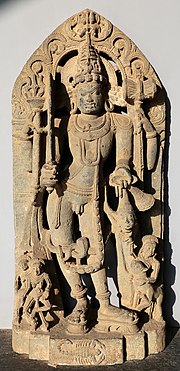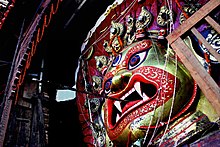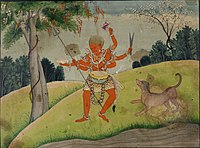| Bhairava | |
|---|---|
 12th-century Bhairava sculpture 12th-century Bhairava sculpture | |
| Affiliation | Shiva |
| Mantra | Oṁ Bhairavāya Namaḥ |
| Weapon | Trishula, Khaṭvāṅga, Sword, Kapala, Sickle, Vajra, Noose, Pinaka bow, Pashupatastra arrow, Pestle and Damaru |
| Day | Monday, Tuesday, or Sunday |
| Number | 33 |
| Mount | Dog |
| Festivals | Bhairava Ashtami |
| Consort | Bhairavi |
| Part of a series on |
| Shaivism |
|---|
 |
|
DeitiesParameshvara (Supreme being) |
| Scriptures and texts |
Philosophy
|
| Practices |
Schools
Saiddhantika Non - Saiddhantika
|
| Scholars |
| Related |
|
|
Bhairava (Sanskrit: भैरव, lit. 'frightful'), or Kāla Bhairava, is a Shaivite and Vajrayāna deity worshipped by Hindus and Buddhists. In Shaivism, he is a powerful manifestation, or avatar, of Shiva. In the tradition of Kashmir Shaivism, Bhairava represents the Supreme Reality, synonymous to Para Brahman. Generally in Hinduism, Bhairava is also called Dandapāni (" danda in hand"), as he holds a rod or danda to punish sinners, and Svaśva, meaning, "he whose vehicle is a dog". In Vajrayana Buddhism, he is considered a fierce emanation of boddhisatva Mañjuśrī, and also called Heruka, Vajrabhairava, Mahākāla and Yamantaka.
Bhairava is worshipped throughout India, Nepal, Indonesia, Sri Lanka, and Japan, as well as in Tibetan Buddhism.
Etymology
Bhairava originates from the word bhīru, which means "fearsome". Bhairava means "terribly fearsome form". It is also known as one who destroys fear or one who is beyond fear.
Hinduism

Legend


The legend of the origin of Bhairava is traced back to a conversation between Brahma and Vishnu described in the Shiva Purana.
Shiva manifested as a pillar of light to settle the dispute of superiority between Brahma and Vishnu. Brahma dishonestly proclaimed his victory, stating that he had discovered the higher end of the pillar of light. To punish him for his dishonesty and arrogance, Shiva produced Bhairava from the region between his brows. When Bhairava sought instruction from Shiva, the deity directed him to "worship Brahma with his sharp-pointed quick-moving sword". Bhairava decapitated the fifth head of Brahma for uttering the falsehood. Vishnu interceded on Brahma's behalf and sought mercy, and the two deities then worshipped Shiva.
Having committed the sin of brahmahatya (the murder of a Brahmin) by decapitating Brahma, Bhairava was pursued by the terrible female personification of the sin. The skull of Brahma was still attached to his hand. To expiate himself of the sin, Bhairava roamed the three worlds. He visited Vaikuntha, where he was honoured by Vishnu and Lakshmi. When Bhairava visited Kashi, the city of the liberated, Brahmahatya left him, and the skull of Brahma was released from his hand.
In another legend, Brahma is regarded to have stated to Vishnu to worship him as the supreme creator of the universe. Noting that both Shiva and he had five heads, Brahma came to believe that he was identical to Shiva and was equal to his powers. When his arrogance started to affect his role in the universe, Shiva threw a lock of his hair from his head. This assumed the form of Bhairava, who decapitated one of Brahma's heads. When the skull (kapala) of Brahma was held in the hand of Bhairava, the creator deity's ego was destroyed and he became enlightened. In the form of Bhairava, Shiva is said to guard each of the Shakti Pithas (A group of temples dedicated to the goddess Shakti). Each Shakti Pitha is accompanied by a temple dedicated to Bhairava.
Depiction


In Kashmir Shaivism, Bhairava is the ultimate form of manifestation.
Trika System
Trika or Kashmiri Shaivism names the Absolute Reality (Para Brahman) as Bhairava. The Vijñāna Bhairava Tantra is a key Tantra text of the Trika System. Cast as a discourse between the god Bhairava and his consort Bhairavi it briefly presents 112 Tantric meditation methods or centering techniques (Dharana). The text is a chapter from the Rudrayamala Tantra, a Bhairava Agama. Bhairavi, the goddess, asks Bhairava to reveal the essence of the way to realization of the highest reality. In his answer Bhairava describes 112 ways to enter into the universal and transcendental state of consciousness. References to it appear throughout the literature of Trika, Kashmir Shaivism, indicating that it was considered to be an important text in the schools of Kashmir Shaiva philosophy and Trika.
List of Bhairavas

The list of manifestations of Shiva:
| This list is incomplete; you can help by adding missing items. (March 2020) |
| This section may require cleanup to meet Misplaced Pages's quality standards. The specific problem is: The names of these manifestations are rendered in regional languages rather than the standard Sanskrit. Please help improve this section if you can. (December 2022) (Learn how and when to remove this message) |
- Batuk Bhairava
- Abhiru
- Akshobhya Bhairava
- Amar
- Ambar
- Amritaksha
- Asitanga Bhairava
- Bagh Bhairava
- Baidyanath
- Bhadrasen
- Bhava
- Bhiruk
- Bhishan
- Bhoothnath Vetal / Betal Bhairava
- Chakrapani
- Chanda
- Chandrashekhar
- Ghanteshwar
- Jogesh
- Kala Bhairava
- Kapalbhairav
- Kapali
- Kapilambar
- Kramadishwar
- Krodhish
- Ksheer Kantak
- Kshetrapaala Bhairava
- Lambkarna
- Maharudra
- Mahodar
- Marthanda
- Matang Bhairava
- Nakuleshwar
- Nandikeshwar
- Nimish
- Pachali Bhairava
- Patal Bhairava
- Rakshaseshwar (Nayanair)
- Rudra Mahadev
- Ruru
- Sambaranand
- Samhaar Bhairava
- Sanhar
- Sanwart
- Sarvanand
- Sarvanand
- Shai Bhairava
- Shri Khutkuni Bhairava
- Sthanu
- Shwet Bhairava
- Swarnakarshan Bhairava
- Trayambak
- Tripuresh
- Trisandhyeshvara
- Tumbeswar
- Umananda or Bhayaanand
- Unmatta Bhairava
- Vakranath
- Vakratund
- Vamana
- Varaha (Baraha)
- Vatsnabh or Dandpani
- Vikrant Bhairava
- Vikritaksh
- Vimocanā
- Viśveśvara
Buddhism

Buddhism also adopted Bhairava (Tibetan: 'Jigs byed; Chinese: Buwei) as a deity and a dharmapala or dharma protector. The various buddhist forms of Bhairava (variously called Herukas, Vajrabhairava, Mahākāla and Yamantaka) are considered fierce deities and yidams (tantric meditational deity) in Tibetan Buddhism. They also have their own set of Buddhist tantras, the Vajrabhairava tantras. According to Tibetan tradition, these tantras were revealed to Lalitavajra in Oddiyana in the tenth century.
These texts play a particularly important role in the Sarma (new translation) traditions of Tibetan Buddhism, especially among the Gelug school where Vajrabhairava is one of the three central highest yoga tantra practices of the lineage.
Bhairava - Mahakala is also popular in Mongolia as a protector deity and was also popular among the Manchus.
The deity is also central to Newar Buddhism. The tantric practices associated with Bhairava focus on the transformation of anger and hatred into understanding.
Worship
See also: Bhairava Ashtami
Temples or shrines to Bhairava are present within or near most Jyotirlinga temples. There are also the sacred twelve shrines dedicated to Shiva which can be found all across India including the Kashi Vishwanath Temple, Varanasi and the Kal Bhairava temple, Ujjain. The Patal Bhairava and Vikrant Bhairava shrines are located in Ujjain as well.
Gorat Kashmiris are known to worship Bhairava during Shivratri. The renowned Hindu reformer, Adi Sankara composed a hymn on Kala Bhairava called "Sri Kalabhairava Ashtakam" in the city of Kashi.
Observances
This section has multiple issues. Please help improve it or discuss these issues on the talk page. (Learn how and when to remove these messages)
|
Bhairava Ashtami, commemorating the day Kala Bhairava appeared on earth, is celebrated on Krishna paksha Ashtami of the Margashirsha month of the Hindu calendar. It is a day filled with special prayers and rituals.
Iconography

Bhairava is depicted as being ornamented with a range of twisted serpents, which serve as earrings, bracelets, anklets, and sacred thread (yajnopavita). He wears a tiger skin and a ritual apron composed of human bones. Bhairava has a dog (shvana) as his divine vahana (vehicle). Bhairavi is a fierce and terrifying aspect of the Devi who is virtually indistinguishable from Kali, with the exception of her particular identification as the consort of Bhairava.
Bhairava himself has eight manifestations called the Ashta Bhairava:
- Asitāṅga Bhairava
- Ruru Bhairava
- Chaṇḍa Bhairava
- Krodha Bhairava
- Unmatta Bhairava
- Kapala Bhairava
- Bhīṣaṇa Bhairava
- Saṃhāra Bhairava
Kala Bhairava is conceptualized as the guru-natha (teacher and lord) of the planetary deity Shani (Saturn).
Bhairava is known as Bhairavar or Vairavar in Tamil, where he is often presented as a grama devata or village guardian who safeguards the devotee in eight directions (ettu tikku). Known in Sinhalese as Bahirawa, he is said to protect treasures. He is the main deity worshipped by the Aghora sect.
Temples
Main article: List of Bhairava temples
Thennaga Kasi Bairavar Temple is a Hindu temple dedicated to Lord Bairavar, a fierce form of Lord Shiva. It is located in Erode, Tamil Nadu, India. This temple is renowned for its unique architectural style and spiritual significance.
Bhairava is an important deity of the Newars of Nepal. All the traditional settlements of Newars have at least one temple of Bhairava. Most of the temples of Bhairava in Nepal are maintained by Tantric Newar priests. There are several Bhairava temples in the Kathmandu valley and other old newar settlements out of valley like Panauti,Banepa, Dhulikhel,Palpa and Pokhara.There are Different Jatras and chariot processions held each year in different newar towns and cities Dedicated to lord Bhairava and these Bhairava jatras are celebrated and continued from several hundreds of years in Nepal.Kalbhairava,Aakash bhairava, Shwet bhairava, Batuk bhairava, Pachali bhairava, aananda bhairava,Unmatta bhairava,mashaan bhairava,Baag bhairava, haygribha bhairava and Kritimukha Bhairava are Bhairavas widely worshipped and believed as the guardians of the Newar settlements.
In south Karnataka, Lord Sri Kalabhairaveshwara is present as Kshetra Palaka in Sri Adichunchanagiri Hills.
Kala Bhairava temples can also be found around Shaktipeeths. It is said that Shiva allocated the job of guarding each of the 52 Shaktipeeths to one Bhairava. There are said to be 52 forms of Bhairava, which are considered a manifestation of Shiva himself. Traditionally, Kala Bhairava is the Grama devata in the rural villages of Maharashtra, where he is referred to as "Bhairava/Bhairavnath" and "Bairavar". In Karnataka, Lord Bhairava is the supreme God for the Hindu community commonly referred to as Vokkaligas (Gowdas). Especially in the Jogi Vokkaliga, he is considered the caretaker and punisher. Shri Kala Bhairava Nath Swami Temple of Madhya Pradesh is also popular.
See also
References
- Kramrisch, Stella (1994). The Presence of Śiva. Princeton, NJ: Princeton University Press. p. 471. ISBN 0691019304
- Gopal, Madan (1990). Gautam, K.S. (ed.). India through the ages. Publication Division, Ministry of Information and Broadcasting, Government of India. p. 76.
- "Bhairava: The Wrathful". Archived from the original on 13 February 2015. Retrieved 13 May 2015.
- ^ Singh, J. (2002). Vijnanabhairava, Or Divine Consciousness: A Treasury of 112 Types of Yoga. Tantra Series. Motilal Banarsidass. p. 1. ISBN 978-81-208-0820-1.
- ^ Wallis, Christopher D. (15 August 2013). Tantra Illuminated: The Philosophy, History, and Practice of a Timeless Tradition. Mattamayura Press. ISBN 978-0-9897613-6-9.
- Sehgal, Sunil (1999). Encyclopaedia of Hinduism: C-G, Volume 2. Sarup & Sons. pp. 491–492. ISBN 978-81-7625-064-1.
- Whalen-Bridge, John; Storhoff, Gary (2009). The Emergence of Buddhist American Literature. State University of New York Press. p. 170. ISBN 978-1-4384-2659-4.
- Davidson, Ronald M. (2003) Indian Esoteric Buddhism: A Social History of the Tantric Movement. Columbia University Press. p. 211. ISBN 0231126190
- Johnson, W. J (1 January 2009). A Dictionary of Hinduism. Oxford University Press. doi:10.1093/ACREF/9780198610250.001.0001. ISBN 978-0-19861-025-0. OCLC 244416793. OL 23224406M. Wikidata Q55879169. (subscription or UK public library membership required)
- Elizabeth Chalier-Visuvalingam (28 May 2013), Bhairava, Oxford University Press, doi:10.1093/OBO/9780195399318-0019, Wikidata Q55919026 (subscription or UK public library membership required)
- Hiltebeitel
- The Śiva Purana, Śatarudra Samhita, chapter 8, The Śiva Purana, part III (English translation), Motilal banarsidass Publishers Private Limited, Delhi, reprint edition (2002), pp. 1097–1103.
- Shastri, J. L. (1 January 2000). The Siva Purana Part 1: Ancient Indian Tradition and Mythology Volume 1. Motilal Banarsidass. pp. 57–60. ISBN 978-81-208-3868-0.
- Shastri, J. L. (1 January 2014). The Siva Purana Part 3: Ancient Indian Tradition and Mythology Volume 3. Motilal Banarsidass. pp. 1103–1109. ISBN 978-81-208-3870-3.
- Johnson W. J. (1 January 2009). A Dictionary of Hinduism. Oxford University Press. doi:10.1093/ACREF/9780198610250.001.0001. ISBN 978-0-19861-025-0. OCLC 244416793. OL 23224406M. Wikidata Q55879169.
- Chalier-Visuvalingam, Elizabeth. "Bhairava's Royal Brahmanicide: The Problem of the Mahābrāhmaṇa", pp. 157–229 in Hiltebeitel
- "Shaktipeeth Bhairava". Archived from the original on 3 March 2016. Retrieved 29 March 2020.
- Buswell, Robert E. Jr.; Lopez, Donald S. Jr. (2013). "Bhairava". The Princeton dictionary of Buddhism. Princeton, NJ. ISBN 978-1-4008-4805-8. OCLC 859536678.
{{cite book}}: CS1 maint: location missing publisher (link) - Siklós, Bulcsu (1996) The Vajrabhairava tantras: Tibetan and Mongolian versions, English translation and annotations, Institute of Buddhist Studies.
- Kapstein, Matthew (2009) Buddhism Between Tibet and China. Wisdom Publicationsv. p. 307. ISBN 0861715810
- ^ Skorupski, Tadeusz. The Buddhist Forum. Vol. 4. pp. 186–187.
- Huntington, John C. and Bangdel, Dina (2003) The Circle of Bliss: Buddhist Meditational Art. Serindia Pubns. p. 468. ISBN 1932476016
- Bansal, Sunita Pant (2008). Hindu Pilgrimage: A Journey Through the Holy Places of Hindus All Over India. Pustak Mahal. ISBN 978-81-223-0997-3.
- Diana L. Eck (1982). Banaras: City of Light. Taylor & Francis. pp. 192–3. ISBN 0-7102-0236-9.
- Ul Hassan, Syed Siraj (1920). The Castes and Tribes of H.E.H. the Nizam's Dominions, Vol. 1. Asian Educational Services. p. 482. ISBN 81-206-0488-1.
- "Hindu Bhakti". hindubhakti.blogspot.com. 27 August 2011. Retrieved 14 April 2015.
- Dwivedi, Bhojraj (2006). Religious Basis Of Hindu Beliefs. Diamond Pocket Books. p. 172. ISBN 81-288-1239-4.
- Bhairava statuette Archived 30 January 2011 at the Wayback Machine in copper from 15th–16th century Nepal, in collection of Smithsonian Institution. Accessed August 11, 2007.
- Christ, Carol P. (1989). "Symbols of Goddess and God in Feminist Theology", in Carl Olson (Ed.) The Book of the Goddess: Past and Present. New York: Crossroads. ISBN 1577662733
- Dalmiya, Vrinda (2000). "Loving Paradoxes: A Feminist Reclamation of the Goddess Kali". Hypatia. 15 (1): 125–150. doi:10.1111/j.1527-2001.2000.tb01082.x. JSTOR 3810514. S2CID 143596725.
- vdocuments.mx_the-kubjika-upanishad-egbert-forsten-56885839dd6b9. p. 7.
- பைரவரைப் போற்றும் தேவாரப் பதிகம்
- பைரவர்
- Harper, Katherine Anne, and Brown, Robert L. (Eds) (2002). The Roots of Tantra. Albany: State University of New York Press.
- Cush, Denise; Robinson, Catherine; York, Michael, eds. (2012). "Hindus in Nepal". Encyclopedia of Hinduism. Routledge. p. 554. ISBN 978-1-135-18979-2.
- "Bhairav Temple – Lord Bhairo Baba". shaligramrudraksha.com. Archived from the original on 15 March 2015. Retrieved 14 April 2015.
- Chalier-Visuvalingam, Elizabeth & Sunthar Visuvalingam (2006). Bhairava in Banaras: Negotiating Sacred Space and Religious Identity. Wiesbaden, Germany: Harrassowitz.
- Parry, Jonathan (1982). "Sacrificial death and the necrophagous ascetic". Death and the Regeneration of Life. Cambridge University Press. pp. 74–110. doi:10.1017/cbo9780511607646.004. ISBN 978-0-521-24875-4.
- Parry, J.P. (1981). "Death and cosmogony in Kashi". Contributions to Indian Sociology. 15 (1–2): 337–365. doi:10.1177/006996678101500118. S2CID 143517233.
- Erndl, Kathleen M. "Rapist or Bodyguard, Demon or Devotee: Images of Bhairo in the Mythology and Cult of Vaiṣṇo Devī", pp. 239–25 in Hiltebeitel
- Sukul, Kubernath (1977). Vārānasī Vaibhava. Patna, India: Bihar Rastrabhasa Parisad
- Lorenzen, David (1972). The Kāpālikas and Kālāmukhas: Two Lost Śaiva Sects. Delhi: Thomson
- Eck, Diana L. (1983) Banaras: City of Light. London: Routledge and Kegan Paul.
Cited sources
- Hiltebeitel, Alf, ed. (1989). Criminal Gods and Demon Devotees: Essays on the Guardians of Popular Hinduism. Albany: State University of New York Press. ISBN 0-88706-982-7.
External links
- Shri Kala Bhairava Mandir, New Delhi Archived 29 January 2017 at the Wayback Machine
| Shaivism | |||||||||||
|---|---|---|---|---|---|---|---|---|---|---|---|
| History | |||||||||||
| Deities |  | ||||||||||
| Texts | |||||||||||
| Mantra/Stotra | |||||||||||
| Traditions | |||||||||||
| Festivals and observances | |||||||||||
| Shiva temples |
| ||||||||||
| Related topics | |||||||||||

